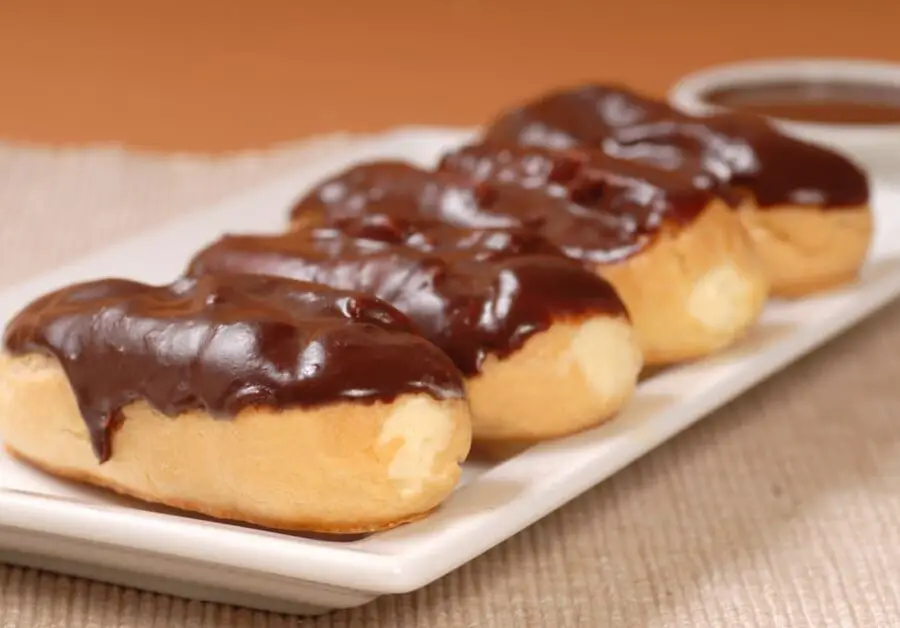At first glance, there may appear to be no difference between an eclair and Long John donuts.
After all, they’re both decadent, creamy and delicious, so it’s hard to wrong with either of them!
However, for the curious among you, there are some significant differences between these beloved pastries, but two primary ones stick out.
The major difference between eclairs and Long John donuts are the type of dough used. Eclairs are made with Choux dough, which uses steam as a leavening agent and are then baked, whereas Long Johns use yeast as a leavening agent and are then fried.
To a lesser degree the fillings used in eclairs versus Long Johns are also a factor since eclairs use traditional French fillings such as crème pâtissière or chiboust cream. Long Johns are usually not filled or in some regions are filled with custard or pudding. Filled Long John donuts are sometimes referred to as filled bars or filled bar donuts.
However, aside from the ingredients discussed above, there are yet other things that make these delicacies unique. Some of these include their origins, the way they’re prepared, and more.
So let’s get right into it and uncover all the scrumptious details!
Origin Differences
As the older of the two, eclairs have a lengthy history and heritage.
It’s believed that they originated in France in the 19th century. During that time, they were not called eclairs but pain à la Duchesse.
A different theory holds that they were the creation of Marie-Antoine Carême. He was a prolific French chef who is not only at least partially credited for the invention of the eclair but of other well known French desserts like the Napoleon cake.
The first known mention of the modern eclair was in 1861 from a Vanity Fair article which was followed in 1884 by a mention in the cookbook for the Boston Cooking School.
The origin of the Long John is not known, but it seems to have taken hold in various parts of the United States, each one referring to the donut differently.
On the East Coast, they are often referred to as eclairs despite the differences between them. In the Midwest, the term Long John is the most used unless it’s filled. Here, it’s called a “cream stick”. Last, on the West Coast, they are referred to as stick donut bars or more simply, bars.
| Pastry | Eclair | Long John |
|---|---|---|
| Origin | France (19th century) | Unknown |
| Creator | Marie-Antoine Carême | Unknown |
| First recorded mention | 1861 (Vanity Fair) | Unknown |
| Name | Eclair | East Coast: Long John, Midwest: Long John (filled: cream stick), West Coast: Stick donut bars or bars |
Pastry Differences
Long Johns are donuts and are made with leavened dough but as opposed to cake donuts, which are leavened with baking powder, Long John donuts are leavened with yeast. They are then fried, and the result is a light and airy texture that keeps a chewy feel in the mouth and a slight flavor of yeast.
Eclairs are made from a special type of pastry known as Choux pastry. Unlike Long Johns, they are not leavened with yeast but with steam. The dough itself is actually a paste made with water, eggs, butter and flour although there are other types made only with water, flour and eggs.
Choux pastry is twice-cooked and allowed to cool before being filled with either sweet or savory ingredients. Once baked, the result is a thin-shelled pastry that features a hollow center where the eclair filling is inserted.
| Pastry | Long John | Eclair |
|---|---|---|
| Type of dough | Leavened with yeast | Choux pastry (leavened with steam) |
| Cooking method | Fried | Twice-cooked, cooled, and then filled and baked |
| Texture | Light and airy with a chewy feel | Thin-shelled with a hollow center |
| Flavor | Slight yeast | Depends on filling |
| Ingredients | Leavened dough, yeast, and other ingredients | Choux pastry ingredients (water, eggs, butter, flour) and filling ingredients |
Icing and Filling Differences
The traditional Long John donut is usually not filled but is a long, flat donut that is covered with glaze or icing. Popular icings for Long John donuts are chocolate and maple. Maple coated Long Johns are also called maple bars.
Sometimes Long Johns can be filled with a vanilla custard, pudding or Bavarian cream. Despite having a custard-like consistency, Bavarian cream is not cooked but is a base of egg yolks and sugar thickened with gelatin.
Eclairs are usually topped with chocolate icing then filled with a custard known as crème pâtissière, whipped cream or chiboust cream.
Crème pâtissière differs from the type of custard used in Long Johns because it contains cornflour. Chiobust cream is a mixture of crème pâtissière and meringue (whipped egg whites). It can also contain gelatin for added stability.
| Pastry | Long John | Eclair |
|---|---|---|
| Shape | Long and flat | Thin-shelled pastry |
| Topping | Glaze or icing (Chocolate, Maple) | Chocolate icing |
| Filling | Vanilla custard, pudding, Bavarian cream | Crème Pâtissière, Whipped cream, Chiboust cream |
| Type of Custard | Traditional custard | Crème Pâtissière (with cornflour) |
| Specialty fillings | Maple bars (maple icing) | Chiboust cream (mixture of Crème Pâtissière and Meringue) |
Differences in Taste
When it comes to differences in taste between eclairs and Long John donuts, this is perhaps where the confusion between them lies.
However, for the discerning palate, the difference is noticeable.
As mentioned earlier, eclairs use Choux pastry, which is mostly composed of eggs. As a result, the shell of the eclair is often much flakier and will have a mix of egg and butter undertones. While the pasty cooks, the interior remains unbaked which lends a gummy texture to it. Once filled, the combination of crunch and cream gives the eclair their signature mouthfeel and flavor.
In contrast, Long John donuts are fried and because of this will have a heavier, denser mouthfeel than eclairs. Additionally, deep frying will bring out the yeast flavor inherent in the dough, making the pasty chewier than the shell of an eclair.
| Pastry | Long John | Eclair |
|---|---|---|
| Dough | Leavened with yeast | Choux pastry (leavened with steam) |
| Cooking method | Fried | Twice-cooked, cooled, and then filled and baked |
| Texture | Heavier and denser, with a chewy feel | Flaky, with a mix of crunch and cream |
| Flavor | Yeasty | Eggy and buttery |
| Mouthfeel | Chewier | Gummy (interior) and crunchy (shell) |

Hiya! I’m Kimberly, a contributing writer here at Miss Buttercup. I was born and raised in the UP, Michigan’s Upper Peninsula for those who don’t know, the land of beautiful, beach-filled sunny summer days and bone-chilling long winters. Growing up there made me appreciate all the little things about life, especially the way a delicious meal can bring people closer together. I try and put that same feeling into each article I write and I hope it comes across that way!

